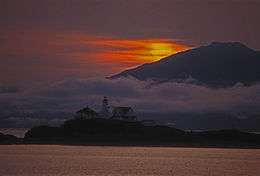Chatham Sound

Chatham Sound is a sound on the North Coast of British Columbia, Canada, bordering on Alaska, United States. It is located between Dundas and Stephens Islands and the Tsimpsean Peninsula near Prince Rupert.[1] It is part of the Inside Passage and extends from Portland Inlet in the north to Porcher Island in the south.[2]
It may have been named in 1788 by British Captain Charles Duncan after John Pitt, 2nd Earl of Chatham, who was First Lord of the Admiralty at that time.[1][2]
Geography
Chatham Sound is a semi-enclosed basin with an area of about 1,600 square kilometres (600 sq mi). It is connected to the open waters of the Hecate Strait and Dixon Entrance via several channels, such as Main, Brown, Hudson Bay, and Edye Passages. Along its southern end, the sound provides access to inland passages such as the Marcus and Arthur Passages, and the Grenville Channel beyond that.[3]
The two major rivers that drain into the sound are the Nass River (via the Portland Inlet) and Skeena River (via the Inverness and Marcus Passages). Because of the large inflow of fresh water the salinity of the sound is lower than the adjacent ocean.[3]
Most of Chatham Sound is less than 100 fathoms (600 ft; 180 m) deep, except in the northern part of the sound where depth exceeds 300 fathoms (1,800 ft; 550 m).[3]
See also
- Chatham Strait - nearby strait in the Alaska Panhandle, named after the first Earl of Chatham
References
- 1 2 "Chatham Sound". BC Geographical Names.
- 1 2 "Chatham Sound - inlet, British Columbia, Canada". www.britannica.com. Encyclopedia Britannica. Retrieved 25 April 2018.
- 1 2 3 Ronald Wilmot Trites (September 1952). "The Oceanography of Chatham Sound, British Columbia" (PDF). www.oceanecology.ca. University of British Columbia. Retrieved 25 April 2018.
| Wikimedia Commons has media related to Chatham Sound. |
Coordinates: 54°22′00″N 130°35′00″W / 54.36667°N 130.58333°W